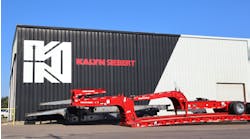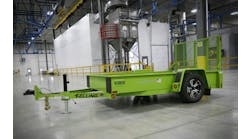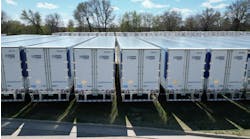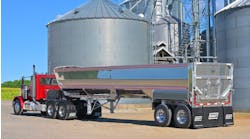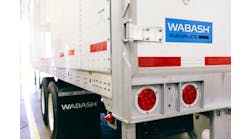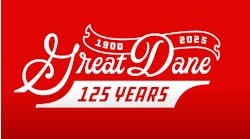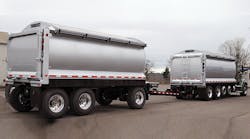SELECTING a proper coupling and drawbar eye for towing a trailer is not unlike consumer or retail shopping. Prior to any purchase, there are typically several questions and details to consider.
For instance, someone shopping for shoes will more than likely know what size he or she needs. They will have a reasonably good idea where, and how often, they will be worn. Will they be worn to work in an office or a gravel pit? Will they be used for dancing or snowboarding, etc.? The only difference between shopping for a pair of shoes and buying a coupling or drawbar eye is the type of questions and details to take into account.
The first step in the coupling and drawbar eye selection process is to determine the towed trailer's Maximum Gross Trailer(s) Weight (MGTW) and Maximum Tongue Weight (MTW). These maximum weights must consider both static and dynamic loading conditions.
The Gross Trailer(s) Weight is usually determined by the Gross Vehicle Weight Rating (GVWR) which is attached to the trailer by the trailer manufacturer. For “Double Trailer” configurations, such as Rocky Mountain doubles or turnpike doubles and for dump and pup units, only the weight of the rear trailer is considered. For “Triple Trailers”, only the two most rearward trailers are used when calculating the MGTW. For example, if the last two trailers have a GVWR of 40,000 pounds each, then 80,000 pounds should be the MGTW value used for the selection process.
The tongue weight of a trailer is the downward force resulting from the weight of the trailer or dolly that acts on the coupling at the coupling to drawbar eye connection. If the drawbar is hinged, the tongue weight is roughly half the weight of the drawbar, or front end. If a non-hinged drawbar is used, such as a stiff-pulled pup, a very rough estimate is to assume the tongue weight is 15% of the GVWR. However, each application and load is unique and the best practice is to weigh the tongue at the drawbar eye when the trailer is loaded to its GVWR.
Weighing the tongue is even more critical when using equipment style, flatbed trailers with axles located near the rear of the trailer. Due to this type of trailer geometry, these units can have a significant tongue weight when loaded. In order to accurately estimate a MTW, one must determine the weight distribution of the heaviest equipment and establish its placement when loaded on the trailer. The trailer manufacturer should be able to lend assistance in calculating the estimated MTW.
Environmental impact
The next step to consider when selecting a coupling or drawbar eye is to determine the environment in which the products will normally be operating. Rough and uneven terrain found during off-road use can dramatically increase the load intensity and frequency exerted on couplings and drawbar eyes. For off-road applications, consider increasing the actual or calculated MGTW and MTW by 25% and then select product based on these new calculated weights.
Some coupling and drawbar eye manufacturers specify their product's capacities must be reduced by 25% if used off-road. This is not the case with Premier Manufacturing Company's products as their rated capacities are valid no matter where they are used.
Certain types of equipment and/or operating practices can also magnify loading conditions through equipment binding or improper loading techniques. Of particular concern are high tongue weight scenarios. Because each application and environment is unique, it may be appropriate to increase the estimated MTW by more than 25% for product selection.
A smooth ride
Another recommendation for off-road applications is the use of an air adjusted or air take-up coupling or drawbar eye. This is a feature has two major benefits:
First, it improves the ride and handling of the unit by reducing trailer bucking. Bucking is caused by the inner diameter of the drawbar eye banging against the pintle, or horn section, of the coupling. The sloppy fit of a large inside diameter drawbar eye coupled to a small diameter pintle will cause bucking that the driver will certainly feel unless an air-adjusted component is used.
The second benefit is the reduction of wear on both the coupling and drawbar eye because wear caused by impact can greatly reduce the life of components.
An air take-up system works by plumbing an air chamber to the emergency side of the truck's airline. Once the emergency brake is released, the air chamber is energized and forces its pushrod against a shoe, or plunger, in the coupling or drawbar eye. The shoe then forces the drawbar eye and pintle together. The magnitude of this force depends on the system's air pressure and size of air chamber. For example, a type 30 air chamber pressurized at 100 psi. forces the pintle and drawbar eye together with approximately 3,000 pounds. of force. Note that an air take-up system should never be considered a locking mechanism. It is simply used to improve ride, handling and wear resistance.
Ties that bind
Off-road applications must also be concerned with the difference in axial articulation between the truck and trailer due to uneven terrain. If the articulation difference is great enough to cause the drawbar eye and coupling to bind, then a swivel component should be used. This is the major reason why dump and pup units almost exclusively use a swivel drawbar eye. As a matter of fact, some coupling and drawbar eye manufacturers state that either a swivel coupling or swivel drawbar eye must be used for any off-road application. This is not a requirement that Premier Mfg. agrees with. If the terrain is not particularly uneven, meaning the coupling and drawbar eye would not bind; there should be no need for a swivel component. But regardless of Premier's policy, it is important to follow the manufacturer's specifications.
One reason for not using or recommending swivel components when not necessary is their vertical capacity limitation. Swivel components have vertical capacities rated well below most rigidly mounted couplings and drawbar eyes and exposing a component to loads above its rated capacity can lead to catastrophic failure.
Increased maintenance
Another reason swivels are not recommended when not necessary is their increased maintenance and inspection requirement. Bushing wear and the resulting loss of preload on the coupling or nut on the drawbar eye shaft must be frequently checked. Loss of preload can increase component wear as well as dramatically decrease the overall strength of the component, which can lead to failure. It is also very important to never use a swivel drawbar eye and swivel coupling together. The reason for this is simple; there would be nothing to prevent the coupling from rotating 180° and operating upside down.
Because stiff-pulled trailers (trailers without a hinged front-end) are still being used in many parts of North America, articulation in a different direction must also be a concern. For instance, the schematic shows a stiff-pulled dump and pup cresting a hill or exiting a gravel pit. Just prior to the trailer reaching the crest of the hill, the coupling on the dump truck can experience “negative tongue weight”. Negative tongue weight occurs when the accumulation of all the forces acting on the trailer result in the drawbar eye attempting to move vertically upward. This is the primary reason why Premier Mfg. publishes every coupling's latch capacity.
The opposite scenario is also possible when a stiff-pulled trailer reaches the bottom of a hill. The trailer's front tire can lift off the ground, or at least support less of the load, which results in a significant increase in positive (downward acting) tongue weight on the coupling. Partially due to these two scenarios, stiff pulled pups are gradually being replaced by hinged front end pup trailers in the US.
Resisting abrasion
Off-road applications are also vulnerable to abrasive wear. The abrasive can come from the load itself, if some kind of aggregate is being hauled, or from simply traveling over a dirt or gravel road.
There are two important steps in combating abrasive wear on couplings and drawbar eyes. The first step is to select a more wear-resistant component. Some manufacturers offer different material and special heat treatments that can withstand abrasive wear better than others.
The second step is to NEVER grease or lubricate the drawbar eye or pintle of the coupling. Grease, oil or other types of lubricant easily collect dirt and sand. It is not difficult to imagine how the grittiness of grease imbedded with sand can act just like sand paper, giving it the ability to grind and wear away even the most hardened steels.
Dust and sand covered grease also make product inspection nearly impossible and therefore becomes a major safety hazard. In fact, Premier Mfg. takes this so seriously that it considers this practice to be an improper maintenance procedure and voids all warranty on any greased drawbar eyes or pintles.
Over-the-road applications are typically less abusive than off-road applications. However, dust and debris are still present on paved roads and highways. As such, lubricating or greasing the pintle and drawbar eye is still prohibited. Pot-holes, train tracks, and speed bumps that over the road vehicles may encounter make the use of an air take-up component a good option.
Consider the alternatives
Aside from load rating and wear differences, couplings also come in various shapes and sizes with some operating in particular niches or markets better than others. For example, there are many different latch styles available, both from within each manufacturer's product line as well as from company to company.
Determining which latch style would work best for a specific application can be very important. For instance, tailboard clearance above the coupling can be an issue. If this scenario exists, the use of either a latching mechanism that opens by rotating upward or one that requires hands above the coupling to operate the latch may not work. Some couplings have latches that open by swinging to the side while others have “low profile” latches that can be operated from the side of the coupling. Both work well in restricted tailboard clearance applications.
The incoming direction or angle the drawbar eye enters the coupling should be considered. If the drawbar eye drops vertically straight down onto the pintle, as in some logging applications, a latch that swings or rotates completely out of the way should be used. If the drawbar eye must enter horizontally, such as in C-dolly or transfer unit applications, then a drop-pintle coupling is recommended. A drop-pintle coupling has a hinged pintle or horn that rotates down and out of the way to release the drawbar eye and then rotates up to the locked close position to capture the drawbar eye.
Make sure it fits
As mentioned earlier, the fit between the drawbar eye and pintle is important, especially if an air take-up system is not used. There are multiple pintle diameters and drawbar eye inside diameters available. Selecting products with too large of a diameter difference can result in bucking which may reduce the truck and trailer's ride and handling. Likewise, products that fit too tight together can limit necessary articulation during cornering or traveling on rough and uneven terrain. Not to mention the fact that a tight fitting pintle and drawbar eye is obviously more difficult to hook-up. To help the consumers, most manufacturers specify which of their couplings and drawbar eyes work and fit together properly.
It is a good idea to select a coupling or drawbar eye that has a standard mounting bolt-hole pattern because purchasing a product with a nonstandard pattern can make future replacement difficult. In the instance the product you selected did not operate or perform as desired, it would be prudent to make sure that other manufacturers offer a similar product that is mounted using the same bolt-hole pattern.
Drawbar eyes are attached to the trailer by bolting, welding or by welding a swivel's housing to a trailer's front end. Premier Mfg. typically recommends a bolt-on drawbar eye for most applications, especially if it is used in abusive environments. This is because they are more easily removed and replaced, resulting in reduced future maintenance costs. Bolt-on drawbar eyes also do not require a certified welder for installation.
The real thing
Finally, the old adage “you get what you pay for” is certainly true with couplings and drawbar eyes. As in almost any industry, there are manufacturers who simply attempt to replicate or copy other company's products.
A cheap imitation Rolex bought from a street vendor may resemble a Rolex on the outside, but does it perform and function like the real thing? Probably not. The same holds true with couplings and drawbar eyes. The only difference is when your watch quits working; you simply won't be able to tell time. If a coupling or drawbar eye fails, lives can be lost.
Prior to purchase, ask the manufacturer what engineering went into the development of the product as well as what tests were performed to validate the design.
Also ask what inspection procedures they use to ensure each product is manufactured to the correct specifications. For instance, most drawbar eyes undergo a secondary heat treatment for increased strength, hardness and wear resistance.
Because there are many variables that must be in place to perform a proper heat treat procedure, make sure the drawbar eye has been hardness tested to qualify the procedure. The telltale sign of a hardness test is a small round indentation of roughly 1/8 of an inch in diameter, residing within a flat ground area somewhere on the drawbar eye loop.
Regardless of the type or manufacturer of coupling and drawbar eye you choose, always follow the manufacturer's installation, inspection and operation instructions. Your installation and operation of these products must also adhere to the Federal Motor Carrier Safety Regulations when operating in the U.S. and the Commercial Vehicle Safety Alliance's Out-of-Service criteria when operating throughout all of North America.
It has been Premier Mfg's experience that most members of the trucking industry understand the significance of proper coupling component selection and realize that an incorrect choice could result in an accident. However, there have been times when it took an accident or critical situation for an end user realize that they either did not thoroughly comprehend their application or they did not properly follow the manufacturer's recommendations and instructions. A proper and sound coupling and drawbar eye selection is critically important to a long service life and many miles of safe transportation.

